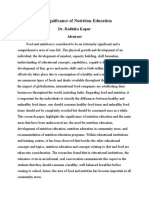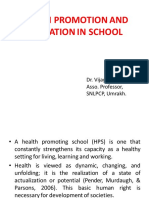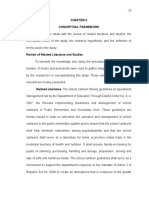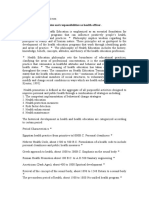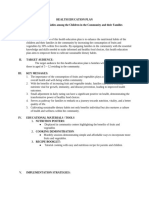0 ratings0% found this document useful (0 votes)
11 viewsNutrition Education
Nutrition Education
Uploaded by
rahafalmidani8Copyright:
© All Rights Reserved
Available Formats
Download as PPTX, PDF, TXT or read online from Scribd
Nutrition Education
Nutrition Education
Uploaded by
rahafalmidani80 ratings0% found this document useful (0 votes)
11 views8 pagesCopyright
© © All Rights Reserved
Available Formats
PPTX, PDF, TXT or read online from Scribd
Share this document
Did you find this document useful?
Is this content inappropriate?
Copyright:
© All Rights Reserved
Available Formats
Download as PPTX, PDF, TXT or read online from Scribd
Download as pptx, pdf, or txt
0 ratings0% found this document useful (0 votes)
11 views8 pagesNutrition Education
Nutrition Education
Uploaded by
rahafalmidani8Copyright:
© All Rights Reserved
Available Formats
Download as PPTX, PDF, TXT or read online from Scribd
Download as pptx, pdf, or txt
You are on page 1of 8
Nutrition Education
1 Healthy eating in childhood improves children’s
health because it positively impacts their growth
and might protect them from the development of
obesity and chronic diseases later in life. The
school environment provides an effective
setting for teaching children about nutrition and
healthy eating. Accordingly, nutrition education
programs have been used over the past few
decades to teach children about nutrition and
provide them with knowledge and skills to make
healthy food choices.
2Nutrition education is not just learning
about food and vitamins; it is for learning
about what to do and how to act to
improve nutrition. Starting nutrition
education in the early school years can be
a suitable opportunity for shaping
children’s thinking about food because
eating habits are formed during childhood.
3 The aim of nutrition education is to develop
positive attitudes towards good food and
physical activity and to provide motivation for
leading a healthy lifestyle. In addition, it aims
to assist children in identifying valid
resources that provide correct information
about healthy food. Nutrition education also
seeks to offer children lifelong know ledge
and skills they can pass on to their own
families and future generations.
4 In general, nutrition education programs
include maintaining healthy weight, food
safety and information about kinds of food
required for the processes of the body and
its growth. Besides, nutrition education
involves various learning activities for
children, staff and parents in a group
setting. They may include presentations,
food preparation, discussions, food tasting
and physical fitness programs.
5 Subsequently, planning nutrition education
programs requires guiding educators on designing a
nutrition curriculum to ensure a well-defined program.
Governments should help by providing fundamental
nutrition concepts to be learned in each grade level
and within subjects such as Life and Earth Sciences.
Also, plans for nutrition education programs need to be
connected with healthy school meals to help children
experience eating nutritious food. Teachers need to
design interesting cooking projects to help children
learn about food. For example, teachers can focus on
cooking vegetables or following a recipe of whole
grains to stress the importance of selecting nutritious
food.
6 A school garden project can help to
reinforce the nutrition education of children
and their families. The main benefit of a
school garden project is that children learn
how to work collaboratively to grow healthy
food and use it for better nutrition. This can
best be done if the garden fresh fruits and
vegetables are used for school meals. Beyond
this, a school garden project would raise
awareness about protecting the environment
7Hence, schools have the ability to
impact future public health. Nutrition
education should start in school not as an
optional subject but a compulsory one
that ends with a final exam; if you fail, it
means you have to do remedial studies.
You might also like
- 101 Juice Recipes - Cross, JoeDocument478 pages101 Juice Recipes - Cross, JoeShivam Patel94% (84)
- Beyond CaloriesDocument28 pagesBeyond CaloriesTyra Lettington100% (3)
- Importance of Physical Activity in Schools Education EssayDocument4 pagesImportance of Physical Activity in Schools Education EssayBuii AhNo ratings yet
- Laboratory Test Report: Test Name Result Biological Reference Interval Serum Status: TriglyceridesDocument1 pageLaboratory Test Report: Test Name Result Biological Reference Interval Serum Status: TriglyceridesUpender Rao SunkishalaNo ratings yet
- Start A School Vegetable Garden by Planting Seeds Indoors or in The GroundDocument4 pagesStart A School Vegetable Garden by Planting Seeds Indoors or in The GroundChromagrafxNo ratings yet
- Assessment Task 1Document5 pagesAssessment Task 1Dorothy PoonNo ratings yet
- Nutrition Education in Primary Schools: Vol. 1: The ReaderDocument2 pagesNutrition Education in Primary Schools: Vol. 1: The ReaderDaisyNo ratings yet
- 12 2assignmentconclusionDocument10 pages12 2assignmentconclusionapi-270353328No ratings yet
- Final Healthy Eating GuideDocument36 pagesFinal Healthy Eating GuideNo BuhleNo ratings yet
- School Health ProgrammeDocument15 pagesSchool Health Programmefooart76No ratings yet
- نسخة نسخة نسخة Eating disorder pptx pptx pptx pptxDocument22 pagesنسخة نسخة نسخة Eating disorder pptx pptx pptx pptxjdydbdyl0No ratings yet
- School Health ProgrammeDocument15 pagesSchool Health ProgrammeZohour AssiriNo ratings yet
- Nutrition Services Research-DesalunaDocument8 pagesNutrition Services Research-DesalunaKate Danielle DesalunaNo ratings yet
- Healthy Eating HabitsDocument4 pagesHealthy Eating HabitsJerimiah OrtizNo ratings yet
- The Dietary Practices of Grade V Pupils of East Alabel District Their Implications To Pupils Academic PerformanceDocument29 pagesThe Dietary Practices of Grade V Pupils of East Alabel District Their Implications To Pupils Academic Performancemariafe tampoyNo ratings yet
- Healthy Eating Phys Act gr8Document33 pagesHealthy Eating Phys Act gr8api-251258441No ratings yet
- Childhood Obesity Oksana Lukashkova Final Correct ExpansionDocument3 pagesChildhood Obesity Oksana Lukashkova Final Correct ExpansionShakniNo ratings yet
- Health Education Plan 2.0Document8 pagesHealth Education Plan 2.0Dianna AsugNo ratings yet
- Week 1Document7 pagesWeek 1Suseth TusoyNo ratings yet
- Kesehatan Gizi Selection 2Document10 pagesKesehatan Gizi Selection 2randykurniawan19No ratings yet
- Chapter One - ThreeDocument26 pagesChapter One - ThreeSamson ikenna OkonkwoNo ratings yet
- Unit I Lesson 2 SC-PEHDocument7 pagesUnit I Lesson 2 SC-PEHJewin OmarNo ratings yet
- Lecture Note 0n SCH HealthDocument11 pagesLecture Note 0n SCH HealthEmilyjNo ratings yet
- Full Projet 15 Decem 2014.docxpdfDocument263 pagesFull Projet 15 Decem 2014.docxpdfIsoken IhensekhienNo ratings yet
- hlth634 Program Plan OutlineDocument8 pageshlth634 Program Plan Outlineapi-299055548No ratings yet
- Feed The Stomach, Nurture The Mind: Proposed Project TitleDocument1 pageFeed The Stomach, Nurture The Mind: Proposed Project TitleAlliya CruzNo ratings yet
- Healthy and Safe School EnvironmentDocument12 pagesHealthy and Safe School EnvironmentERLI CADUNGOGNo ratings yet
- Group 1 Eapp Concept Paper 3Document7 pagesGroup 1 Eapp Concept Paper 3kymbtznNo ratings yet
- The Significance of Nutrition Education: Dr. Radhika KapurDocument12 pagesThe Significance of Nutrition Education: Dr. Radhika KapurTitis Retno Sawitri SawitriNo ratings yet
- Team ZaletaDocument35 pagesTeam ZaletaAnsley San Juan DelvalleNo ratings yet
- What Are The Proposed Resolutions or Answers To This Global Challenge?Document1 pageWhat Are The Proposed Resolutions or Answers To This Global Challenge?Nica Lopez FernandezNo ratings yet
- School Health ProgrammeDocument6 pagesSchool Health ProgrammeSurendra Paudel100% (2)
- Action Research Improving Nutritional Status of Filipino ChildrenDocument6 pagesAction Research Improving Nutritional Status of Filipino ChildrenGhia Cressida HernandezNo ratings yet
- Study Guide 11Document9 pagesStudy Guide 11Fiona LozanoNo ratings yet
- HEBD ProposalDocument5 pagesHEBD Proposaljas02h1No ratings yet
- Class Newsletter FinalDocument2 pagesClass Newsletter Finalapi-299543324No ratings yet
- Wellness Policy Draft June 6 2014Document4 pagesWellness Policy Draft June 6 2014api-204868647No ratings yet
- Health Promotion and Education in School - VL PDFDocument28 pagesHealth Promotion and Education in School - VL PDFAshu AmmuNo ratings yet
- Grant ProposalDocument14 pagesGrant Proposalapi-583548081No ratings yet
- Childhood Obesity Oksana Lukashkova Final InjectedDocument3 pagesChildhood Obesity Oksana Lukashkova Final InjectedShakniNo ratings yet
- School Based FoodDocument40 pagesSchool Based FoodSusana AndradeNo ratings yet
- Fshn322groupproject FinalDocument15 pagesFshn322groupproject Finalapi-241264551No ratings yet
- Nutrition ServicesDocument15 pagesNutrition ServicesKate Danielle Desaluna100% (1)
- Infant New Version EditedDocument10 pagesInfant New Version EditedMathEng TeachNo ratings yet
- Lancina Tabitha Session9 Ppe310Document8 pagesLancina Tabitha Session9 Ppe310api-302219446No ratings yet
- CanteenDocument3 pagesCanteenmehta.siddharth0707No ratings yet
- Promoting HealthDocument14 pagesPromoting HealthPetra BajićNo ratings yet
- Nutrition Curriculum For Asia & The South PacificDocument52 pagesNutrition Curriculum For Asia & The South PacificHeifer InternationalNo ratings yet
- Lesson 2 Pe and Health 3eDocument80 pagesLesson 2 Pe and Health 3ekenneth021376No ratings yet
- Healthy FoodDocument10 pagesHealthy FoodMaria R.No ratings yet
- Health Promoting Schools Policy - 2004Document20 pagesHealth Promoting Schools Policy - 2004Shafeeu Mohamed0% (1)
- Components of Coordinated School Health ProgramDocument14 pagesComponents of Coordinated School Health ProgramJudit PangilinanNo ratings yet
- Packed LunchesDocument23 pagesPacked LunchesAmin AksherNo ratings yet
- Jonalyn Chapter 2 Edited 2 22Document34 pagesJonalyn Chapter 2 Edited 2 22evangeline san jose100% (1)
- #Community NutritionDocument23 pages#Community Nutritionأحمد سعيد النكلاويNo ratings yet
- Light Blue Creative Modern Medical Clinic PresentationDocument44 pagesLight Blue Creative Modern Medical Clinic PresentationCrasel Shiene SaguisabalNo ratings yet
- Food PreparationDocument9 pagesFood PreparationliclicantantanNo ratings yet
- The Role of Parents: More Information About Children's Diet Information About Physical Activity in ChildrenDocument4 pagesThe Role of Parents: More Information About Children's Diet Information About Physical Activity in ChildrenjabirNo ratings yet
- Advocacy BrochureDocument2 pagesAdvocacy Brochureapi-253369640No ratings yet
- LET Competency: Roles and Responsibilities As Health OfficerDocument6 pagesLET Competency: Roles and Responsibilities As Health OfficerNoldan King FranciscoNo ratings yet
- Health Education PlanDocument5 pagesHealth Education PlanDianna AsugNo ratings yet
- 218-1688040213Document6 pages218-1688040213SandhiyaNo ratings yet
- Exploring Baby-Led Feeding: A Stress-Free Approach to Introducing Solids.From EverandExploring Baby-Led Feeding: A Stress-Free Approach to Introducing Solids.No ratings yet
- Biopsych Trans Chap 12Document20 pagesBiopsych Trans Chap 12Chantelle SiyNo ratings yet
- Safety and Sanitation in Food PreparationDocument50 pagesSafety and Sanitation in Food PreparationRhea Mae Torres100% (1)
- Minerals ReviewerDocument7 pagesMinerals ReviewerGyra Marie AgraNo ratings yet
- Rubric For Cooking Activity and Plating PresentationDocument3 pagesRubric For Cooking Activity and Plating PresentationRacquel EscotonNo ratings yet
- GEO166 Problem 1Document5 pagesGEO166 Problem 1JOHN EDRIAN VILLAREALNo ratings yet
- Adult Module 2 - Picky Eaters (ENGLISH)Document3 pagesAdult Module 2 - Picky Eaters (ENGLISH)Maria Eleonor BanaresNo ratings yet
- CLA N Lipid in RuminantsDocument46 pagesCLA N Lipid in RuminantsTamii MatulNo ratings yet
- Introduction of Health, Nutrition, and SafetyDocument9 pagesIntroduction of Health, Nutrition, and SafetyLUSTER JOANN SANCHEZNo ratings yet
- Rio Catalog 12Document8 pagesRio Catalog 12chloerioNo ratings yet
- Preparation of Soyabean Milk and Its Comparison With Natural Milk 2 PDFDocument18 pagesPreparation of Soyabean Milk and Its Comparison With Natural Milk 2 PDFDheeraj Kumar100% (1)
- NDT Reviewer Carbo Lipid ProteinDocument8 pagesNDT Reviewer Carbo Lipid ProteinMyrel Cedron TucioNo ratings yet
- Product LaunchingDocument6 pagesProduct LaunchingKharyl Ann CatapusanNo ratings yet
- The Impact of Food Labels On The Food Choices of College of Education Students of University of The East - ManilaDocument10 pagesThe Impact of Food Labels On The Food Choices of College of Education Students of University of The East - ManilaCARLCEDDRIC ROSARIONo ratings yet
- Coc 1 NciiiDocument9 pagesCoc 1 NciiiFlor PeraltaNo ratings yet
- Chemistry Project 12 Casein PDFDocument11 pagesChemistry Project 12 Casein PDFrohitmj599No ratings yet
- Technical Sheet Cherry MangoDocument2 pagesTechnical Sheet Cherry MangoIsabel AramburoNo ratings yet
- Resume of Nutrition, Food, and HealthDocument11 pagesResume of Nutrition, Food, and HealthFikrah Hafiz SuniNo ratings yet
- Critical Review On Principles and Applications of Hurdle Technology in Food PreservationDocument7 pagesCritical Review On Principles and Applications of Hurdle Technology in Food PreservationRaselNo ratings yet
- Basic Anthropometry in Adults and ChildrenDocument32 pagesBasic Anthropometry in Adults and Childrennajeeb500100% (1)
- "Health Is Not Valued Till Sickness Comes.": Tips FOR Better Digestiv E HealthDocument2 pages"Health Is Not Valued Till Sickness Comes.": Tips FOR Better Digestiv E HealthhaddieNo ratings yet
- Q4 Performance TaskDocument4 pagesQ4 Performance TaskLouiejane LapinigNo ratings yet
- What Is Proper Nutrition and A Well-Balanced Diet?Document2 pagesWhat Is Proper Nutrition and A Well-Balanced Diet?helloaNo ratings yet
- Impact of Fast FoodDocument15 pagesImpact of Fast FoodAashish PashineNo ratings yet
- Sugar Chemistry: The Canadian Food and Drug Regulations (FDR) Govern The Following DefinitionsDocument2 pagesSugar Chemistry: The Canadian Food and Drug Regulations (FDR) Govern The Following Definitionsshankar santhanamNo ratings yet
- Jute Facts, Health Benefits and Nutritional ValueDocument12 pagesJute Facts, Health Benefits and Nutritional Valueacd1355No ratings yet
- Processing of Triticale: Pondicherry UniversityDocument9 pagesProcessing of Triticale: Pondicherry UniversityNIDHARSHANA S100% (1)
- q2 Module Ks3 Grade10 CookeryDocument67 pagesq2 Module Ks3 Grade10 Cookerylinarubino351No ratings yet




























